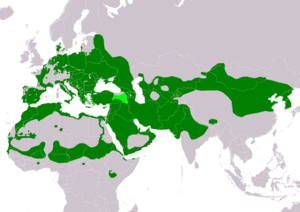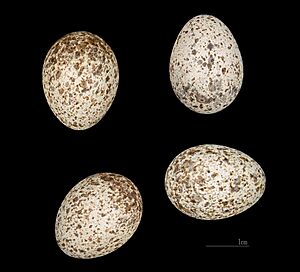Crested lark facts for kids
Quick facts for kids Crested lark |
|
|---|---|
 |
|
| At Sultanpur National Park, India | |
| Conservation status | |
| Scientific classification | |
| Genus: |
Galerida
|
| Species: |
cristata
|
| Subspecies | |
|
See text |
|
 |
|
| Approximate range of G. cristata Breeding Resident | |
| Synonyms | |
|
|
The crested lark (Galerida cristata) is a type of lark bird. It lives across many parts of Eurasia and northern Africa. This bird does not usually migrate to other places. Sometimes, it might fly to places like Great Britain by accident.
Contents
What is a Crested Lark?
The crested lark is a small, brown bird. It has a special feathery crest on its head. This crest is always visible. It becomes even more noticeable when the bird is singing or looking for a mate.
How Big are Crested Larks?
These larks are about the same size as a Eurasian skylark. They are about 17 centimeters (6.7 inches) tall. Their wings can spread from 29 to 38 centimeters (11 to 15 inches). They weigh between 37 and 55 grams (1.3 to 1.9 ounces).
What Do They Look Like?
Crested larks have a short tail with light brown outer feathers. Male and female larks look very similar. Young larks have more spots on their backs. When they fly, you can see reddish feathers under their wings. They look a lot like the Thekla lark. One way to tell them apart is by their beaks. The Thekla lark also has heavier black-brown streaks.
Where Do Crested Larks Live?
Crested larks live in many warm parts of Eurasia. Their range goes from Portugal all the way to north-eastern China and eastern India. In Africa, they live south to Niger.
Their Home Environment
These birds like dry, open areas. You can often spot them by roadsides or in fields. They also live in small, sandy spots near railways, docks, and airfields. They do not usually migrate, meaning they stay in one place.
Where They Used to Live
Crested larks used to be found in Sweden until the 1990s. They are no longer found there since 1993. They have also disappeared from countries like Norway (1972), Luxembourg (1973), and Switzerland (1980s).
Crested Lark Behaviour
The crested lark is known for its beautiful song. It sounds like a "whee-whee-wheeoo" or "twee-tee-too."
Singing and Flying
They sing while flying high in the sky. They can be 30 to 60 meters (100 to 200 feet) above the ground. Unlike the Eurasian skylark, the crested lark sings mostly when it's already high up or on the ground. It does not sing much while flying upwards.
How They Move
Their flight pattern is wavy, which is called undulatory locomotion. This means they fly up and down in a wave-like motion.
Life and Family of Crested Larks
Crested larks build their nests in small dips on the ground. They often choose empty lands or the edges of towns.
Building a Nest
Their nests are a bit messy. They are made mostly of dead grasses and roots. The female lays three to five eggs at a time. These eggs are brown with small speckles. They look similar to the eggs of the Eurasian skylark.
Hatching and Growing Up
The eggs hatch after about 11 to 12 days. Like most larks, the chicks leave the nest early. They usually leave after about eight days. They learn to fly when they are 15 to 16 days old. Crested larks usually raise two groups of chicks each year.
What Do They Eat?
Crested larks are mostly vegetarian. They eat grains and seeds like oats, wheat, and barley. But they also eat insects, especially beetles. They find their food on the ground or dig it up. Both parents feed the young birds. The young birds often leave the nest to find food for themselves even before they can fly well.
Crested Larks and People
Francis of Assisi, a famous saint, thought the crested lark was a very special bird. He saw similarities between the bird and the life of the Friars Minor. He noted its plain, earth-colored feathers and hood. He also admired its humility, saying it "goes willingly along the wayside and finds a grain of corn for itself." He also liked that it spent time singing.
Are Crested Larks in Danger?
The IUCN Red List of Threatened Species says the crested lark is of "least concern." This means it is not currently in danger of disappearing.
Population Numbers
Experts believe there are between 22 million and 91.2 million adult crested larks worldwide. In Europe, there are an estimated 3.6 million to 7.6 million breeding pairs. This means there are between 7.2 million and 15.2 million individual birds.
Population Trends
Even though there are many crested larks, their numbers in Europe have been going down since 1982. This suggests that the global population might also be decreasing.
Images for kids







